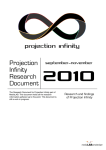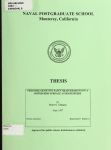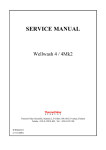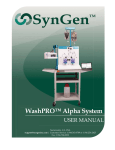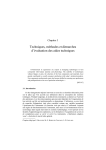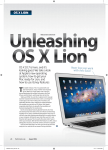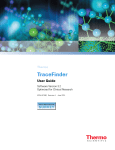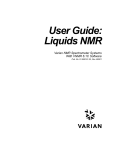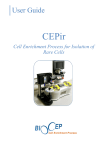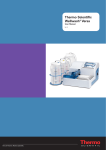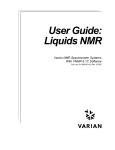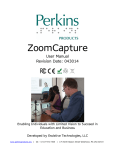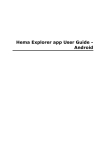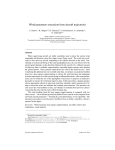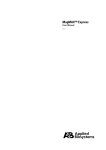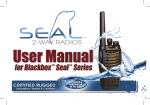Download 1507340_ver2.4 Wellwash 4 Mk 2 User Manual
Transcript
Wellwash Thermo Scientific Wellwash 4 Mk 2 User Manual Rev. 2.4, Cat. no. 1507340 Wellwash Thermo Scientific Wellwash 4 Mk 2, Cat. no. 5160772 (115 V), 5160770 (230 V) or 5160771 (100 V) User Manual Rev. 2.4; November 2008, Cat. no. 1507340 Copyright Copyright 2008 Thermo Fisher Scientific. All rights reserved. Printed in Finland. Reproduction of the accompanying user documentation in whole or in part is prohibited. Trademarks ( and ) Wellwash is a registered trademark of Thermo Fisher Scientific. All other trademarks and registered trademarks are the property of their respective holders. Disclaimer Thermo Fisher Scientific reserves the right to change its products and services at any time to incorporate technological developments. This manual is subject to change without prior notice as part of a continuous product development. Although this manual has been prepared with every precaution to ensure accuracy, Thermo Fisher Scientific assumes no liability for any errors or omissions, or for any damages resulting from the application or use of this information. This manual supersedes all previous editions. No liability for consequential damages Thermo Fisher Scientific shall not be liable for any damages whatsoever arising out of the use or inability to use this product. Contact information Thermo Fisher Scientific Oy P.O. Box 100, FI-01621 Vantaa, Finland Tel. +358-9-329 100, Fax +358-9-3291 0415 www.thermo.com Rev. 2.4, Cat. no. 1507340 Table of Contents Table of Contents 1 Safety Symbols and Markings .................................................................... 7 3 Introduction to the Wellwash 4 Mk 2 .......................................................... 9 2 4 5 6 7 8 9 10 11 12 13 About the User Manual............................................................................ 8 Functional Description ...........................................................................11 Installation..........................................................................................13 Operation ...........................................................................................26 Maintenance........................................................................................36 Troubleshooting ...................................................................................49 Technical Specifications .........................................................................55 Ordering Information.............................................................................57 Warranty Certificate .............................................................................58 Index .................................................................................................59 Glossary and Abbreviations .....................................................................63 Appendix A: Wellwash 4 Mk 2 Quick Reference Guide ....................................................64 Appendix B: Certificate of Decontamination ................................................................65 Appendix C: Wellwash 4 Mk 2 Feedback Form..............................................................66 Appendix D: Addresses ...........................................................................................67 Notes .................................................................................................68 Thermo Scientific Wellwash® 4 Mk 2 User Manual Rev. 2.4, Cat. no. 1507340 3 Table of Contents Table of Contents 1 Safety Symbols and Markings .................................................................... 7 3 3.1 3.2 3.3 Introduction to the Wellwash 4 Mk 2 .......................................................... 9 Intended use ..........................................................................................9 Principle of operation ...............................................................................9 Advantages of using Wellwash 4 Mk 2 ............................................................9 2 4 4.1 5 5.1 5.2 5.2.1 5.2.2 5.2.3 5.2.4 5.2.5 5.2.6 5.3 5.3.1 5.3.2 5.3.3 5.3.4 5.4 6 6.1 6.2 6.3 6.4 6.5 6.5.1 6.5.2 6.6 6.7 6.7.1 6.7.2 6.8 7 7.1 7.1.1 7.1.2 7.1.3 7.1.4 7.1.5 7.1.6 7.1.7 7.1.8 About the User Manual............................................................................ 8 Functional Description ...........................................................................11 Controls and indicators ........................................................................... 12 Installation..........................................................................................13 Installation check list ............................................................................. 13 What to do upon delivery......................................................................... 13 How to unpack.................................................................................... 13 Checking delivery for completeness .......................................................... 14 Checking for damage during transport ....................................................... 15 Environmental requirements................................................................... 16 Things to avoid ................................................................................... 16 Technical prerequisites ......................................................................... 16 Installation procedure............................................................................. 17 How to install the pump unit and washer unit connections .............................. 19 Wash head height ................................................................................ 23 Mains supply cable ............................................................................... 24 Changing wash heads ............................................................................ 24 Operational check ................................................................................. 24 Operation ...........................................................................................26 Operational checklist.............................................................................. 26 Washing a microplate ............................................................................. 27 Priming procedure ................................................................................. 29 Adding wash reagent .............................................................................. 30 Program selection.................................................................................. 31 Two-way switch functions ...................................................................... 32 Rotary switch functions ......................................................................... 33 Resetting ............................................................................................ 35 Shutdown procedure............................................................................... 35 Daily shutdown procedure ...................................................................... 35 Long-period shutdown........................................................................... 35 Emergency situations.............................................................................. 35 Maintenance........................................................................................36 Regular and preventive maintenance .......................................................... 36 Service contracts ................................................................................. 36 Maintenance check list.......................................................................... 36 General ............................................................................................ 36 Immediate ......................................................................................... 37 Tubing .............................................................................................. 37 Reagent / waste bottles ........................................................................ 37 Liquid trap bottle ................................................................................ 38 Pinch valve ........................................................................................ 42 Thermo Scientific Wellwash® 4 Mk 2 User Manual Rev. 2.4, Cat. no. 1507340 4 Table of Contents 7.1.9 7.1.10 7.2 7.3 7.3.1 7.4 7.4.1 7.5 Unclogging tips ................................................................................... 42 Fuse replacement ................................................................................ 44 Disposal of materials .............................................................................. 46 Decontamination procedure...................................................................... 46 How to decontaminate the instrument ...................................................... 46 How to pack for service........................................................................... 47 Packing............................................................................................. 48 Disposal of the instrument ....................................................................... 48 9 9.1 9.2 9.3 Technical Specifications .........................................................................55 General specifications ............................................................................ 55 Safety specifications .............................................................................. 56 In conformity with the requirements ........................................................... 56 8 8.1 8.2 8.3 8.3.1 8.3.2 8.3.3 8.4 8.5 8.5.1 8.5.2 8.6 10 10.1 10.2 11 11.1 12 13 13.1 13.2 Troubleshooting ...................................................................................49 Troubleshooting guide............................................................................. 49 Service request protocol.......................................................................... 52 Limitations, warnings and cautions ............................................................. 52 Liquid reservoir – IMPORTANT.................................................................. 52 Electrical .......................................................................................... 52 Mechanical and environmental ................................................................ 53 Defects and abnormal stresses .................................................................. 54 Before operation ................................................................................... 54 Installation ........................................................................................ 54 In operation ....................................................................................... 54 Cleanliness .......................................................................................... 54 Ordering Information.............................................................................57 List of accessories.................................................................................. 57 List of recommended spare parts ............................................................... 57 Warranty Certificate .............................................................................58 Warranty limitations............................................................................... 58 Index .................................................................................................59 Glossary and Abbreviations .....................................................................63 Keywords for web pages .......................................................................... 63 Literature............................................................................................ 63 Appendix A: Wellwash 4 Mk 2 Quick Reference Guide ....................................................64 Appendix B: Certificate of Decontamination ................................................................65 Appendix C: Wellwash 4 Mk 2 Feedback Form..............................................................66 Appendix D: Addresses ...........................................................................................67 Notes .................................................................................................68 Thermo Scientific Wellwash® 4 Mk 2 User Manual Rev. 2.4, Cat. no. 1507340 5 List of Figures and List of Tables List of Figures Fig. Fig. Fig. Fig. Fig. Fig. Fig. Fig. Fig. Fig. Fig. Fig. Fig. Fig. Fig. Fig. Fig. Fig. Fig. Fig. Fig. Fig. Fig. Fig. Fig. Fig. Fig. Fig. Fig. Fig. Fig. Fig. 4.1 4.2 5.1 5.2 5.3 5.4 5.5 5.6 5.7 5.8 5.9 5.10 5.11 5.12 5.13 5.14 5.15 5.16 6.1 6.2 6.3 7.1 7.2 7.3 7.4 7.5 7.6 7.7 7.8 7.9 7.10 7.11 Wellwash 4 Mk 2 microplate washer .................................................. 11 Keypad..................................................................................... 12 Accessories included with the instrument. .......................................... 14 Spare tubing .............................................................................. 15 Wash arm assembly tubing ............................................................. 15 Location of the frequency selector switch and the transit screws ............... 17 Pinch valve holder ....................................................................... 18 Installing the O rings to the wash head holders ..................................... 18 Sliding the wash head between the holders ......................................... 19 Pump unit with tubes installed ........................................................ 19 Liquid level sensor system.............................................................. 20 Removing the plastic caps .............................................................. 21 Connection of pump and washer units................................................ 21 Opening and closing the bottle ........................................................ 22 Correct position of the plate carrier ................................................. 22 Loosening the locknut with spanners ................................................. 23 Changing the wash head ................................................................ 24 Placing the microplate with 12-way and 8-way wash head........................ 25 Releasing the pressure from the wash bottle........................................ 30 Preprogrammed card: three washes with a 12-way wash head ................... 31 Programmable switch card ............................................................. 32 Liquid level sensor and liquid trap bottle cover .................................... 38 Opening the liquid trap bottle cover ................................................. 39 Pulling the thick tube out of the liquid trap bottle ................................ 40 Pulling the thin tube out of the liquid trap bottle ................................. 40 Opening the liquid trap bottle......................................................... 41 Unpinching the tube ..................................................................... 42 De-clogging the wash head ............................................................. 43 Opening the fuse holder of the washer unit ......................................... 44 Washer unit fuse and fuse holder ..................................................... 44 Opening the fuse holder of the pump unit........................................... 45 Pump unit fuse holder opened......................................................... 45 List of Tables Table Table Table Table Table Table Table Table Table Table Table 5.1 5.2 6.1 6.2 6.3 6.4 6.5 6.6 6.7 7.1 8.1 Installation check list ................................................................... 13 Silicon tubing color-codes .............................................................. 19 Operational checklist ................................................................... 26 Number of washes after a soak period ............................................... 33 Aspiration after the final wash........................................................ 33 Soak period (in minutes)................................................................ 33 Pause (in seconds) between each washing cycle .................................... 34 Number of washes before soaking..................................................... 34 Washing volume (in µl).................................................................. 34 Maintenance check list.................................................................. 36 Troubleshooting list ..................................................................... 50 Thermo Scientific Wellwash® 4 Mk 2 User Manual Rev. 2.4, Cat. no. 1507340 6 Chapter 1: Safety Symbols and Markings 1 Safety Symbols and Markings These symbols are intended to draw your attention to particularly important information and alert you to the presence of hazards as indicated. Safety symbols and markings used on the Wellwash 4 Mk 2 Power ON Power OFF SN Serial number REF Catalog number Date of manufacture Consult Instructions for Use IVD In Vitro Diagnostic Medical Device WEEE symbol This product is required to comply with the European Union’s Waste Electrical & Electronic Equipment (WEEE) Directive 2002/96/EC. Warning markings used in the documentation Warning: Risk of electric shock. Warning: Biohazard risk. Warning: Risk of injury to the user(s). Caution: Risk of damage to the instrument, other equipment or loss of performance or function in a specific application. Other markings used in the documentation Note: Marks a tip, important information that is useful in the optimum operation of the system, or an item of interest. Thermo Scientific Wellwash® 4 Mk 2 User Manual Rev. 2.4, Cat. no. 1507340 7 Chapter 2: About the User Manual 2 About the User Manual This User Manual has been written for the actual user (e.g., laboratory technician) and provides information on the Thermo Scientific Wellwash 4 Mk 2 microplate strip washer, including installation and operating instructions. Read the manual in its entirety prior to operating the instrument. This User Manual has been designed to give you the information you need to: Review safety precautions Carry out washing procedures Install the Wellwash 4 Mk 2 Perform basic maintenance procedures Maintain the instrument Troubleshoot the instrument performance This User Manual also describes features and specifications of the Wellwash 4 Mk 2 hardware and on-board software. Chapter 6 explains the operating procedures. The user should be familiar with the contents of Chapter 7 on maintenance procedures that may be performed by the user. For warranty and ordering information, refer to Chapters 10 Ordering Information and 11 Warranty . Thermo Scientific Wellwash® 4 Mk 2 User Manual Rev. 2.4, Cat. no. 1507340 8 Chapter 3: Introduction to the Wellwash 4 Mk 2 3 Introduction to the Wellwash 4 Mk 2 The Wellwash 4 Mk 2 is a semiautomatic microplate washer, comprising pump and washer units. The instrument is supplied with both 8- and 12-way wash heads, four program cards and an accessory pack. Your local Thermo Fisher Scientific representative can arrange instrument training at the commissioning of the instrument for extra charge, if required. 3.1 Intended use The Wellwash 4 Mk 2 is a microplate washer for 96-well plates. It can be used in research or routine-test laboratories by trained personnel to wash Microtiter microplates and strips in 96-well plate format that meet the SBS standards. For verification of the entire system, it is recommended that Good Laboratory Practices (GLP) be followed to guarantee reliable analyses. Use for self-testing is excluded. If the assay performance is essential for the analysis, the test result has to be ensured with internal quality controls or with an alternative test. 3.2 Principle of operation The instrument provides the following wash functions initiated through the keypad and control switches or a preprogrammed wash card: 1. Liquid dispensing into wells (microplate or microstrip) 2. Liquid aspiration from wells (microplate or microstrip) With their unique and proven design, the coaxial wash heads of the Wellwash 4 Mk 2 ensure excellent washing efficiency and low residual volumes of less than 5 µl. For clean delivery of washing buffer, the inner dispensing tubes are made of stainless steel. A continuous vacuum in the outer tube prevents cross contamination and ensures complete liquid removal. For fast and accurate selection of routine protocols, the Wellwash 4 Mk 2 comes with four standard program cards (1 to 4 washing cycles) as well as a programmable card. This switch card permits a quick selection of all wash parameters, including soak times and final wash protocols. The quick release bottle caps of the Wellwash 4 Mk 2 ensure easy buffer changes. An additional rinse bottle can be connected, making it easier to purge wash buffer from the wash head or change to a different wash buffer. Automatic pump shutdown reduces wear and noise levels. If unused for 30 seconds, the wash pump of the Wellwash 4 Mk 2 automatically switches off. 3.3 Advantages of using Wellwash 4 Mk 2 The Wellwash 4 Mk 2 provides several advantages relating mainly to the principle of operation in that it has: Unique coaxial wash heads for trouble-free washing and low residual volumes 8- and 12-way interchangeable wash heads Excellent washing performance Easy to program Quick release wash/waste bottle caps Automatic pump shutdown Thermo Scientific Wellwash® 4 Mk 2 User Manual Rev. 2.4, Cat. no. 1507340 9 Chapter 3: Introduction to the Wellwash 4 Mk 2 Effective liquid management Thermo Scientific Wellwash® 4 Mk 2 User Manual Rev. 2.4, Cat. no. 1507340 10 Chapter 4: Functional Description 4 Functional Description The Wellwash 4 Mk 2 is designed to wash wells in an 8 x 12 microplate. It comprises a pump unit and a washer unit (Fig. 4.1), which are connected by power, air and liquid lines. The pump unit consists of a double-headed vacuum pump with high-density polythene reagent and waste bottles and a liquid trap. The main power ON/OFF switch is at the rear of the pump unit. The frequency selector switch is located on the bottom side of the pump model Cat. no. 5190771 near the transport locking screws. The keypad is located on the left-hand side of the washer unit and the microprocessor and associated control electronics are housed under the keypad. The wash head is located above the plate carrier slideway, which can be either 8- or 12-way. The plate carrier moves the microplate accurately beneath the wash head and incorporates a priming reservoir at its leading edge. The plate carrier is indexed forward by means of a magnetic coupling to the drive system housed inside the washer. 6 5 7 3 8 1 9 4 1 0 2 1 1 1 2 1. 2. 3. 4. 5. 6. 7. Pump unit Washer unit Waste bottle Wash bottle Bottle caps Liquid level sensor Liquid trap bottle Fig. 4.1 8. 9. 10. 11. 12. 13. 14. 1 3 Wash arm assembly Wash head and wash head holders Priming reservoir Keypad Plate carrier Program card Pinch valve 1 4 Wellwash 4 Mk 2 microplate washer The pump creates pressure to the wash bottle (Fig. 4.1, item 4) allowing the wash liquid to be dispensed through the pinch valve (Fig. 4.1, item 14) into the microplate wells and a vacuum to the waste bottle (Fig. 4.1, item 3) to aspirate the used wash liquid into the waste bottle. Thermo Scientific Wellwash® 4 Mk 2 User Manual Rev. 2.4, Cat. no. 1507340 11 Chapter 4: Functional Description 4.1 Controls and indicators Here is a description of the controls and indicators on the Wellwash 4 Mk 2. POWER ON/OFF switch This two-position switch at the rear of the pump unit controls the electrical power to both the pump and washer units. PRIME push button A momentary action switch that starts the PRIME function. An audible tone will sound when pressed to confirm operation. PRIME indicator This yellow LED (light-emitting diode) located to the right of the PRIME button flashes to indicate that the PRIME function is required and, when continuously ON, indicates that the washer is primed and ready for use. The indicator will turn off after a while, but the instrument remains ready for use. ROW SELECT (1 – 12) push buttons These are momentary action switches that select the last row to be washed in any chosen program sequence. An audible tone will sound when pressed to confirm operation. ROW SELECT indicators These yellow LEDs located to the right of the ROW SELECT push buttons, when illuminated, indicate the rows selected for washing. START push button This momentary action switch initiates the wash cycle. An audible tone will sound when pressed to confirm operation. RESET push button When pressed, the RESET button will reset the washer to its pre-programmed state. An audible tone will sound when pressed to confirm operation. POWER indicator This green LED is located at the bottom left of the keypad and, when illuminated, indicates that the POWER switch is ON. VAC FAIL indicator A yellow LED which, when flashing, indicates that the waste bottle is full or that there is a vacuum failure. Fig. 4.2 Keypad Thermo Scientific Wellwash® 4 Mk 2 User Manual Rev. 2.4, Cat. no. 1507340 12 Chapter 5: Installation 5 5.1 Installation Installation check list The section on installation will contain an outline of the points mentioned in the check list below. Table 5.1 Installation check list Tick Item Unpack the Wellwash 4 Mk 2 instrument carefully. Refer to 5.2.1. Keep the original packaging and packing material for future transportation. 5.2 Check the delivery for completeness. Refer to 5.2.2. Check for damage during transport. Refer to 5.2.3. Place the instrument on a normal laboratory bench taking into account both the environmental and technical prerequisites. Refer to 5.2.4 and 5.2.6. Leave sufficient clearance on both sides and at the rear of the unit. Install the instrument: Remove the transit screws. Refer to 5.3, step 1. Check the voltage and frequency of the electrical supply. Refer to 5.3, step 2. Remove the pinch valve holder. Refer to 5.3, step 4. Install the wash head. Refer to 5.3, steps 5 and 6. Connect the tubing and the liquid level sensor cord to the pump unit. Refer to 5.3.1, steps 1 to 5. Connect the washer unit to the pump unit. Refer to 5.3.1, steps 6 and 7. Fill the wash bottle and tighten both bottle caps. Refer to 5.3.1, steps 8 and 9. Slide the plate carrier to its place. Refer to 5.3.1, step 10. Connect the mains supply cable (cord) to the mains input socket. Refer to 5.3.2. Carry out the operational check. Refer to 5.4. What to do upon delivery 5.2.1 How to unpack Move the unpacked instrument to its site of operation. Unpack the Wellwash 4 Mk 2 instrument and accessories carefully with the arrows on the transport package pointing upwards. The following notes and instructions are sent with the instrument and are immediately available when you open the package: the Warranty Certificate card the Transportation discrepancy report the packing instructions/packing list the User Manual Caution: DO NOT touch or loosen any screws or parts other than those specially designated in the instructions. Doing so might cause misalignment and will invalidate the instrument warranty. Fig. 4.1 shows the pump and washer units in their entirety. Thermo Scientific Wellwash® 4 Mk 2 User Manual Rev. 2.4, Cat. no. 1507340 13 Chapter 5: Installation Lift out the washer and pump units, removing the shaped packing pieces from around the washer, and place them on a flat level surface. To lift the instrument, put your fingers under the bottom on both sides and lift it with your back straight. The net weight of the instrument is 10 kg (22 lbs.). Caution: When unpacking the instrument, it is recommended that two people lift the instrument together, taking proper precautions to avoid injury. Retain the original packaging and packing material for future transportation. The packaging is designed to assure safe transport and minimize transit damage. Use of alternative packaging materials may invalidate the warranty. Also, retain all instrument-related documentation provided by the manufacturer for future use. Note: Before use remember to remove the transit screws at the bottom of the instrument and save them in the adjoining screw holes (marked with the text "Transit screw storage"). Remove and save the pinch valve holder until needed for future transportation of the instrument. 5.2.2 Checking delivery for completeness Check the enclosed packing list against order. In case of any deviations, contact your local Thermo Fisher Scientific representative or Thermo Fisher Scientific Oy. The instrument is supplied with both 8- and 12-way wash heads, four program cards, the user manual, the mains supply cable and an accessory pack. The content of the accessory pack is shown in Fig. 5.1 and Fig. 5.2. Store the accessories in their bags until you need them. 2 1 6 3 4 5 1. 2. 3. 4. 5. 6. 7. 7 Combiplate 4 spare fuses (see Section 7.1.10 Fuse replacement) 2 Allen keys (see Section 5.3 Installation procedure, step 1) 2 spanners (see Section 5.3.2 Wash head height) De-clogging tool (see Section 7.1.9 Unclogging tips) 6 spare O rings for the bottle caps 4 spare O rings (see Section 5.3 Installation procedure, step 5) Fig. 5.1 Accessories included with the instrument. Thermo Scientific Wellwash® 4 Mk 2 User Manual Rev. 2.4, Cat. no. 1507340 14 Chapter 5: Installation 1 2 3 4 6 5 1. 2. 3. 4. 5. 6. Waste liquid spare tube Reagent liquid spare tube Pinch valve spare tubes (item 3 in Fig. 5.3) (see Section 7.1.8 Pinch valve) Wash arm assembly spare tube (item 2 in Fig. 5.3) Wash arm assembly spare tube (item 4 in Fig. 5.3) Wash arm assembly spare tube (item 1 in Fig. 5.3) Fig. 5.2 Spare tubing 1 2 3 4 Fig. 5.3 Wash arm assembly tubing 5.2.3 Checking for damage during transport Visually inspect the transport package, the instrument and the accessories for any possible transport damage. If the carton has been damaged in transit, it is particularly important that you retain it for inspection by the carrier in case there has also been damage to the instrument. Neither the manufacturer nor its agents can be held responsible for any damage incurred in transit, but the manufacturer will make every effort to help obtain restitution from the carrier. Upon receipt of the carrier's inspection report, arrangements will be made for repair or replacement. Visually check all interconnections in the basic instrument. Check that there are no loose parts inside the instrument. If any parts are damaged, contact your local Thermo Fisher Scientific representative or Thermo Fisher Scientific Oy. Thermo Scientific Wellwash® 4 Mk 2 User Manual Rev. 2.4, Cat. no. 1507340 15 Chapter 5: Installation 5.2.4 Environmental requirements When you set up your Wellwash 4 Mk 2, avoid sites of operation with excess dust, vibrations, strong magnetic fields, direct sunlight, draft, excessive moisture or large temperature fluctuations. Make sure the working area is flat, dry, clean and vibration-proof and leave additional room for accessories, cables, wash bottles, etc. Leave sufficient space (at least 10 cm) on both sides and at the back of the unit to allow adequate air circulation. Make sure the ambient air is clean and free of corrosive vapors, smoke and dust. Make sure the ambient temperature range is between +5°C (41 F) and +40°C (104 F), preferably between +15°C (59 F) and +25°C (77 F). Make sure relative humidity is between 10% and 90% (non-condensing). Note: The use of the instrument in strong, direct sunlight or next to radiators and other heat sources may markedly increase the temperature prevailing at the instrument. This should be taken into account when deciding where the instrument should be located and operated. The Wellwash 4 Mk 2 does not produce operating noise at a level that would be harmful. No sound level measurements are required after installation. Warning: DO NOT operate the instrument in an environment where potentially damaging liquids or gases are present. 5.2.5 Things to avoid DO NOT smoke, eat or drink while using the Wellwash 4 Mk 2. Wash your hands thoroughly after handling test fluids. Observe normal laboratory procedures for handling potentially dangerous samples. Use proper protective clothing. Use disposable gloves. Be sure the working area is well ventilated. Never spill fluids in or on the equipment. Only use the instrument for its intended purpose. Refer to Section 3.1. 5.2.6 Technical prerequisites The washer and pump units require no special site preparations. A normal laboratory bench close to a mains supply socket is quite suitable. The net weight of the instrument is 10 kg (22 lbs.). Check that the voltage label on the rear panel of the pump unit conforms to the supply voltage used in the laboratory. The instrument operates at voltages of 100 – 120 Vac, 220 – 240 Vac and the frequency range 50/60 Hz (see Section 5.3, step 2). Thermo Scientific Wellwash® 4 Mk 2 User Manual Rev. 2.4, Cat. no. 1507340 16 Chapter 5: Installation 5.3 Installation procedure Any suitably skilled person using standard tools may carry out the following procedure. 1. Rest the pump unit on its side and remove the transit screws (the Allen cap head type is painted red) using the key supplied (Fig. 5.1, item 5). Relocate them in the retaining holes provided (Fig. 5.4). Note: When relocating this instrument or returning it for repair, it is essential that the transit screws are refitted. Failure to do so could invalidate the warranty. 2. Ensure that the pump mains switch is in the OFF position. After checking that the electrical supply conforms to that specified on the voltage label on the rear panel of the unit, slide the frequency selector switch (in the pump model Cat. no. 5160771) to the 50 Hz or 60 Hz position depending on the mains supply voltage frequency (Fig. 5.4). (Other pump models do not include a frequency selector.) 2 1 3 1. 2. 3. Location of the frequency selector switch Retaining holes for the transit screws Transit screws during transportation Fig. 5.4 Location of the frequency selector switch and the transit screws 3. Turn the pump unit back to its normal position. Thermo Scientific Wellwash® 4 Mk 2 User Manual Rev. 2.4, Cat. no. 1507340 17 Chapter 5: Installation 4. Lift the wash arm assembly (the stainless steel cover). Remove the pinch valve holder (Fig. 5.5) before use. Store the wire holder for future use. Pinch valve holder Fig. 5.5 Note: Pinch valve holder The wash heads are packed separately. Install them before use. 5. Install first the four (4) small O-rings to the wash head holders, two (2) on both sides (Fig. 5.6). Fig. 5.6 Installing the O rings to the wash head holders Thermo Scientific Wellwash® 4 Mk 2 User Manual Rev. 2.4, Cat. no. 1507340 18 Chapter 5: Installation 6. Slide the wash head between the holders (Fig. 5.7). Note: Fig. 5.7 The wash heads will only fit into the end slots when the raised flange on the wash head is facing the front. Sliding the wash head between the holders 5.3.1 How to install the pump unit and washer unit connections Fig. 5.8 Pump unit with tubes installed 1. The wash bottle with the black connections is located on the right-hand side of the pump unit and the waste bottle to the left. All the tubing and connections are color coded to ensure correct connection (Table 5.2). Table 5.2 Silicon tubing color-codes Black Yellow Red Blue Pressure feed from the pump to the wash bottle Pressuring wash reagent from the wash bottle to the washer unit Vacuum feed from the pump to the waste bottle Waste feed from the washer unit to the waste bottle Thermo Scientific Wellwash® 4 Mk 2 User Manual Rev. 2.4, Cat. no. 1507340 19 Chapter 5: Installation 2. Connect the pressure feed from the pump on the right to the wash bottle using the black-coded tube. 3. Connect the vacuum feed tube (red) from the pump to the waste bottle (Fig. 5.9, item 2). 4. Connect the liquid level sensor cord from the liquid trap bottle to the waste bottle. Make sure the black connector is firmly in place (Fig. 5.9, item 1). Caution: The liquid level sensor does not function if the connector is not properly inserted: the black connector has to be pushed down all the way. The waste bottle may otherwise overfill and cause the liquid trap bottle to start filling. If at that point the liquid trap bottle is not emptied, the overflowing waste liquid can enter the pump unit and damage it. 1 2 3 1. 2. 3. Liquid level sensor connector Vacuum feed tube Liquid trap bottle cover Fig. 5.9 Liquid level sensor system 5. Check that the tubes are properly connected to the pinch valve under the wash arm assembly on the washer unit (Fig. 4.1, item 14). The thin tube going through the valve should not be pinched by the edges of the valve. Thermo Scientific Wellwash® 4 Mk 2 User Manual Rev. 2.4, Cat. no. 1507340 20 Chapter 5: Installation 6. Remove the three (3) black plastic caps from the hose connectors and the pump control at the rear of the washer unit (Fig. 5.10). Fig. 5.10 Removing the plastic caps 7. Slide the two units together until the locating dowel and electrical connectors are firmly engaged (Fig. 5.11). 4 1 5 2 6 7 3a 3b 1. 2. 3. 4. 5. 6. 7. Silicone tube (waste, blue color code) Manifold pipes (PRESSURE for reagent tube/yellow, VACUUM for waste tube/blue) Locating pin (a) and friction bush (b) Silicone tube (wash, yellow color code) Signal connectors (with text PUMP CONTROL) Silicone tube (pressure, black color code) Pump pressure adjustment screw (do not touch –for authorized service personnel only!) Fig. 5.11 Connection of pump and washer units Thermo Scientific Wellwash® 4 Mk 2 User Manual Rev. 2.4, Cat. no. 1507340 21 Chapter 5: Installation 8. Open the wash bottle (Fig. 4.1, item 4) by rotating the cap ring, while the white plug remains stationary. Lift the cap ring and open the plug. Fill the wash bottle up to the shoulder with wash reagent and reconnect ensuring that the plug mates correctly with the bottle insert (Fig. 5.12) and that the cap ring is tightly screwed down. Cap ring Plug Fig. 5.12 Opening and closing the bottle 9. Tighten the cap on the waste bottle. 10. Lift the wash head and slide the plate carrier onto the stainless steel slideway so that the reservoir is under the wash head (Fig. 5.13). 1 2 3 1. 2. 3. Wash head Priming reservoir Plate carrier Fig. 5.13 Correct position of the plate carrier Thermo Scientific Wellwash® 4 Mk 2 User Manual Rev. 2.4, Cat. no. 1507340 22 Chapter 5: Installation 5.3.2 Wash head height To accommodate the differences in size and volume capacity of manufacturers’ microplates, the height of the wash head is adjustable. This means that a positive meniscus can always be obtained without an unnecessary waste of wash reagent. The wash head is factory-set at a nominal height to suit the most commonly used microplates. Should adjustment be required follow these instructions: 1. Make sure the wash bottle is empty to facilitate the adjustment. Start a simple wash routine and wait until the wash arm assembly starts to slide backwards. Turn OFF the instrument from the power switch at the back of the pump unit. The wash head is now in the raised position. 2. A stainless steel head lift rod is located on the left-hand side of the washer unit immediately above the keypad. There is a domed nut at the top of the rod with a locknut underneath. 3. Perform the adjustment using the two spanners 5.5/6.0 supplied with the instrument. Fig. 5.14 Loosening the locknut with spanners 4. Loosen the locknut (Fig. 5.14) by keeping the 6.0-spanner stationary while turning the 5.5-spanner clockwise. 5. Adjust the height by rotating the domed nut, clockwise to lower the wash head and anticlockwise to raise the wash head. 6. Set the tips of the wash head to approx. 1.5 mm to 2.0 mm above the height of a microplate on the plate carrier, when the wash head is in the raised position. 7. Lock the domed nut into position with the locknut. When locking the domed nut into position, keep it still with the spanner 6.0 and only rotate the locknut anticlockwise using the spanner 5.5. Thermo Scientific Wellwash® 4 Mk 2 User Manual Rev. 2.4, Cat. no. 1507340 23 Chapter 5: Installation 5.3.3 Mains supply cable Warning: Never operate your instrument from a power outlet that has no ground connection. Never use a mains supply cable (cord) other than the Thermo Scientific mains supply cable designed for your region. 1. Ensure that the mains switch at the rear of the pump unit is in the OFF position. 2. Connect the mains supply cable (cord) to the mains input socket at the rear of the pump unit. If you need to use any other type of mains supply cable than supplied, use only cables certified by the local authorities. 3. Connect the instrument to a correctly installed line power outlet that has a protective conductor that is grounded (earthed). 5.3.4 Changing wash heads You can change the wash head to either 8-way or 12-way. Lift the head assembly (Fig. 4.1, item 8), grasp the wash head (Fig. 4.1, item 9) at both ends and slide it down in the direction of the tips until it clears the end caps. Check that the two O rings in each end cap are in position and undamaged. To install the alternative wash head, slide it upwards onto the slots making sure that it is fully engaged (Fig. 5.7). Fig. 5.15 Changing the wash head Note: The wash heads will only fit into the end slots when the raised flange on the wash head is facing the front. Remember to check the program card accordingly (8-way or 12-way). 5.4 Operational check The following procedure should be completed to confirm the correct functioning of the washer prior to normal use. 1. Check that the wash head is correctly located by means of its guide slots in the head assembly (Fig. 5.7). The operational check is performed faster with the 12-way wash head. 2. Add approximately 2 to 3 dl of distilled aqua to the wash bottle and make sure that both bottle caps are firmly tightened. 3. Switch ON the mains power supply by depressing the POWER ON switch positioned on the rear panel of the pump unit. The POWER indicator on the keypad (Fig. 4.2) will be illuminated and a countdown sequence will begin on the row indicators. The row 12 indicator will illuminate first followed by row 11, row 10, row 9, and so on, at onesecond intervals until the PRIME indicator is reached. The pressure Thermo Scientific Wellwash® 4 Mk 2 User Manual Rev. 2.4, Cat. no. 1507340 24 Chapter 5: Installation generation takes 10 seconds. The PRIME indicator continues flashing to prompt the user to prime the system. 4. Select the preprogrammed wash card for 1 wash and for the 12-way wash head. Plug it into the slot on the right-hand side of the washer unit (Fig. 4.1, item 13). 5. Lift the wash head and slide the plate carrier onto the stainless steel slideway so that the reservoir is under the wash head (Fig. 5.13). 6. The instrument should now be primed. Press the PRIME button to initiate the sequence. The wash head will lift and the pinch valve will open for one second allowing wash fluid to flow into the priming reservoir. The wash head will then lower itself to empty the prime reservoir. The PRIME indicator will turn off when the priming is complete. If no further key entry is made within ten (10) seconds of priming, the pump will automatically switch OFF. The instrument will then enter its idle state, waiting for instructions from the keypad and program card. 7. Place a microplate onto the plate carrier. When using a 12-way wash head, the well A1 of the microplate should be positioned in the top left-hand corner. When using an 8-way wash head, the well A1 should be positioned in the top right-hand corner. See Fig. 5.16. A1 A1 Fig. 5.16 Placing the microplate with 12-way and 8-way wash head 8. Select the row number of the last row to be washed on the keypad (e.g., when button 4 is pressed, rows 1 to 4 will be washed). Note: When the 12-way program card is installed, buttons 9 to 12 are inoperative. 9. Press the START button to set the washing cycle into operation. The plate carrier will be drawn into the washer, filling and aspirating each row according to the sequence selected on the program card. At the end of a sequence, rows will be left substantially dry and the plate carrier will stop with the priming reservoir under the wash head. 10. The instrument is performing properly, if the wells are dry. If they are not, check that both bottle caps are firmly closed Thermo Scientific Wellwash® 4 Mk 2 User Manual Rev. 2.4, Cat. no. 1507340 25 Chapter 6: Operation 6 6.1 Operation Operational checklist Table 6.1 Operational checklist Tick Item Fill the wash bottle with appropriate washing reagent. Select the program card and insert it. When using the programmable switch card, check the settings. Switch the instrument ON. Prime the instrument. Place a microplate onto the plate carrier. Select the row number of the last row to be washed. Start the wash sequence. When the wash sequence has finished, remove the microplate. Shut down the instrument. The following symbols are used in the flowchart below: key Perform action Thermo Scientific Wellwash® 4 Mk 2 User Manual Press the key. Indicates the actions you should take. Rev. 2.4, Cat. no. 1507340 26 Chapter 6: Operation 6.2 Washing a microplate Fill the wash bottle and empty the waste bottle Ensure that the instrument is switched OFF. Open the wash bottle cap (Fig. 6.1) very carefully to release any residual pressure. Let the hissing sound end prior to opening the cap all the way. Fill the wash bottle with appropriate washing reagent and tighten the bottle cap firmly (see Fig. 5.12). Plug the program card into the slot Select either one of the preprogrammed wash cards or the programmable switch card (see Section 6.5). Position the plate carrier for priming Position the plate carrier on its slideway with the priming reservoir to the rear under the wash head (see Fig. 5.13). Turn the instrument ON PRIME Place the microplate onto the plate carrier 1– 12 START Remove the microplate from the plate carrier Before inserting any program card, ensure that it is clean and dry. Wiping the surfaces with a soft dry cloth will suffice. If any liquid is present on the card, a malfunction of the program may occur. The POWER indicator on the keypad (Fig. 4.2) illuminates and a countdown sequence will begin on the row indicator LEDs. The PRIME indicator flashes until you prime the system (Section 6.3). The priming function is complete when the PRIME indicator turns OFF. If no further key entry is made within fifteen seconds of priming, then the pump will automatically switch OFF. The instrument will then enter the idle state, waiting for instructions from the keypad and program card. Check that the correct wash head (8-way or 12-way) is fitted. Check that the plate is placed properly onto the plate carrier (Fig. 5.16). Select the row number of the last row to be washed. If no row is selected, the whole plate will be washed. The instrument performs the wash sequence. After pressing the START button, there may be a delay of up to 15 seconds before the run begins to allow the reagent and waste bottles to reach the working pressure. The plate carrier will advance into the washer aspirating and filling selected rows in the sequence determined by the program card fitted. On completion of the protocol, the plate carrier will come to rest with the wash head lowered into the priming reservoir. Turn the instrument OFF Thermo Scientific Wellwash® 4 Mk 2 User Manual Rev. 2.4, Cat. no. 1507340 27 Chapter 6: Operation Warning: If the instrument is used in a manner not specified by the manufacturer, the protection provided by the instrument may be impaired. See Section 9.1 General specifications. Caution: Handle the microplate with care to avoid any contamination of the instrument and the subsequent specimens. The contamination of the specimen will lead to incorrect results. If the contents of the microplate does spill, however, follow the decontamination procedure presented in Section 7.3. Also, follow the system supplier's instructions in regard to the reagent kit and specimen handling in the event of contamination. Warning: Never open the wash bottle, detach any of the tubing or press the black top of the pinch valve without first releasing the pressure by slightly opening the bottle cap. Let the hissing sound end prior to opening the cap all the way. Warning: If you are using a washing reagent that is either volatile or splashes easily, keep yourself at a safe distance from the instrument while it is operating to avoid exposure. Place the instrument into a fume hood. Warning: When washing microplates with samples of human or animal origin, keep yourself at a safe distance from the instrument while it is operating to avoid exposure. Place the instrument into a fume hood. Note: If the pump fails to start or if the bottle caps are loose, an audible warning will be heard and the VAC FAIL indicator will illuminate. This condition will clear once the pump has started. If the VAC FAIL indicator does not clear after the pump has started, the RESET key must be depressed. Also, check that the waste bottle is not full. Note: The priming procedure must be repeated whenever the POWER switch has been engaged or if there has been an interruption of the power supply. Caution: Make sure that sufficient reagent is present in the wash bottle to complete the required protocol. See Fluid consumption in Section 9.1 General specifications. Caution: If you use the programmable switch card, ensure that the 8 WAY – 12 WAY switch is in the correct position (for either the 8-way or the 12-way wash head). Caution: If removable-well microplates are being used, make sure that there are no missing wells in the rows to be washed and that all the wells are at the same level. Note If you press the RESET button on the keypad at any stage, this will stop the immediate washing sequence and reset the system to its preprogrammed state. Caution: DO NOT smoke, eat or drink while using the Wellwash 4 Mk 2. Wash your hands thoroughly after handling test plates. Observe normal laboratory procedures for handling potentially dangerous plates. Use proper protective clothing. Use disposable gloves. Ensure that the working area is well ventilated. Thermo Scientific Wellwash® 4 Mk 2 User Manual Rev. 2.4, Cat. no. 1507340 28 Chapter 6: Operation 6.3 Caution: Never spill fluids in or on the equipment. Prevent any liquid from entering the instrument. Caution: Immediately wipe away spilled liquids from outer surfaces to prevent damage and wipe over with a mild detergent. Caution: Keep the instrument free of dust and other foreign matter. Clean the plate carrier and the plate carrier slideway and keep them dry to prevent jamming. Priming procedure Position the plate carrier on its slideway with the priming reservoir to the rear under the wash head (see Fig. 5.13). Press the PRIME button. The wash head will lift and the pinch valve will open for one second allowing wash fluid to flow into the priming reservoir. The wash head will then lower itself to empty the priming reservoir. The priming function is complete when the PRIME indicator turns OFF. If no further key entry is made within ten seconds of priming, the pump will automatically switch OFF. The instrument will then enter the idle state, waiting for instructions from the keypad and program card. If the pump fails to start or if the bottle caps are loose, an audible warning will be heard and the VAC FAIL indicator will illuminate. This condition will clear once the pump has started. If the VAC FAIL indicator does not clear after the pump has started, the RESET key must be depressed. Check also that the waste bottle is not full. Note: The priming procedure must be repeated whenever the POWER switch has been operated or if there has been an interruption of the power supply. Thermo Scientific Wellwash® 4 Mk 2 User Manual Rev. 2.4, Cat. no. 1507340 29 Chapter 6: Operation 6.4 Adding wash reagent To add wash reagent, first release the pressure from the wash bottle by carefully opening the bottle cap (see Fig. 6.1). Let the hissing sound end prior to opening the cap all the way. Fig. 6.1 Releasing the pressure from the wash bottle Also, when you are changing the used reagent and you wish to rinse and clean the tubing, first release the pressure from the tubing and the wash bottle by slightly opening the wash bottle cap. Close the wash bottle tightly (Fig. 5.12). The waste bottle needs to be emptied when the wash bottle is filled. Thermo Scientific Wellwash® 4 Mk 2 User Manual Rev. 2.4, Cat. no. 1507340 30 Chapter 6: Operation 6.5 Program selection Choose an appropriate card for the wash routine. Plug the card into the slot located at the base to the right of the washer unit. Note: Before inserting any program card, ensure that it is clean and dry. Wiping the surfaces with a soft dry cloth will suffice. If any liquid is present on the card, a malfunction of the program may occur. Note 1: If a run is started without a program card or any row selection, the instrument will signal an error by sounding the audible warning device 3 times. Note 2: If a run is started with the rows selected but with no program card inserted, the instrument aspirates the rows selected and returns to its idle state with the wash head lowered into the priming reservoir. Note 3: If a run is started without any rows selected but with a program card fitted, the instrument will aspirate all the rows in accordance with the card configuration, i.e., 8-way or 12-way wash head. The preprogrammed wash cards will dispense and aspirate the plate row by row for the number of times indicated on the card. There are four cards which can be inserted either side up to perform the wash routine indicated on the side facing up. Fig. 6.2 Preprogrammed card: three washes with an 8-way wash head Thermo Scientific Wellwash® 4 Mk 2 User Manual Rev. 2.4, Cat. no. 1507340 31 Chapter 6: Operation Contained on the programmable switch card are four (4) rotary type and nine (9) two-way type switches each marked with their function. The setting of these switches controls the function of the washer, enabling a wide variety of protocols to be performed. Fig. 6.3 Programmable switch card 6.5.1 Two-way switch functions SINGLE Switch settings Make sure that this switch is always set to single wash head. — 8 WAY 12 WAY PLATE STRIP Use with an 8-way wash head. Use with a 12-way wash head. All selected rows are washed once, the instrument waits during the PAUSE setting, and the following wash cycle is started. STEPOFF The plate carrier will only pass over the selected rows. With this selection, the plate processing times are kept to a minimum. WASHLO The wash head fills the well while rising from the bottom of the well. WET The plate will remain filled after washing. Use this setting with soak period. F WET The plate will remain filled after the final wash. Thermo Scientific Wellwash® 4 Mk 2 User Manual Each row is washed the set number of times (WASHES). The PAUSE setting is between each row. STEPOVR The plate carrier will pass over all the rows, not washing the rows not selected. With this selection, the time used for each plate remains constant. WASHHI The wash head fills the well from the raised position. DRY The plate will be aspirated after washing. F DRY The plate will be aspirated after the final wash. Rev. 2.4, Cat. no. 1507340 32 Chapter 6: Operation F1 OFF – FINAL X1 and F2 OFF – FINAL X2 Table 6.2 Number of washes after a soak period Settings F1 OFF F2 OFF F1 OFF FINAL X2 FINAL X1 FINAL X1 Number of washes 0 F2 OFF 1 2 FINAL X2 3 PLATE – STRIP and WET – DRY Table 6.3 Aspiration after the final wash PLATE PLATE STRIP STRIP Settings WET No aspiration (wells filled) DRY All rows aspirated after the final wash DRY Each row aspirated after its final wash WET No aspiration (wells filled) 6.5.2 Rotary switch functions SOAK Set the soak period (Table 6.4), which commences after all the presoak wash routines (WASHES) are complete. Make sure you have selected WET. Table 6.4 Soak period (in minutes) Setting 0 1 2 3 4 5 6 7 Setting 8 9 A B C D E F Soak time (minutes) Soak time (minutes) 0 4.0 Thermo Scientific Wellwash® 4 Mk 2 User Manual 0.5 4.5 1.0 5.0 1.5 6.0 2.0 7.0 2.5 8.0 Rev. 2.4, Cat. no. 1507340 3.0 9.0 3.5 10.0 33 Chapter 6: Operation PAUSE Set the pause between each wash cycle (Table 6.5). During the strip wash mode, the pause is between each row. During the plate wash mode, the pause is between each pass over the plate. Note: The times currently available are subject to approval and may be altered to suit individual customer requirements. Table 6.5 Pause (in seconds) between each washing cycle 0 1 2 3 4 5 6 7 0 1 2 3 4 5 6 7 Plate wash mode (seconds) 0 5 10 15 20 25 30 40 Setting 8 9 A B C D E F 8 9 10 15 20 30 45 60 50 60 75 85 105 120 180 240 Setting Strip wash mode (seconds) Strip wash mode (seconds) Plate wash mode (seconds) WASHES Set the number of washes to be performed before a soak period (Table 6.6). Table 6.6 Number of washes before soaking Setting 0 1 2 3 4 5 6 7 Setting 8 9 A B C D E F Number of washes Number of washes *) No wash, only aspirate 0*) 8 1 9 2 10 3 11 4 12 5 13 6 14 7 15 VOLUME Set the volume dispensed during washing (Table 6.7). Table 6.7 Washing volume (in µl) Setting 0 1 2 3 4 5 6 7 Setting 8 9 A B C D E F Washing volume (µl) Washing volume (µl) Note: 0 400 50 450 100 500 150 550 200 600 250 650 300 700 350 750 The dispense volume is less than the wash volume to avoid overfilling the wells. Thermo Scientific Wellwash® 4 Mk 2 User Manual Rev. 2.4, Cat. no. 1507340 34 Chapter 6: Operation 6.6 Resetting 6.7 Shutdown procedure If you press the RESET button on the keypad at any stage, this will stop the immediate washing sequence and reset the system to its pre-programmed state. Warning: Remove any microplate still on the plate carrier. Dispose of all microplates and strips as biohazardous waste. The wash reagents may contain buffer salts, which can crystallize when the washer is not in use. This may cause clogging of the wash/aspirate tips. To avoid this, the following procedures should be followed. 6.7.1 Daily shutdown procedure When the last wash cycle of the day is complete, switch the power OFF through the switch at the rear of the pump unit. Fill the priming reservoir of the plate carrier with distilled water and lower the wash head tips into the priming reservoir. Do not detach the tubes unless you first open the wash bottle cap slightly to release the pressure. Wipe the instrument surfaces with a soft cloth or tissue paper moistened with deionized distilled aqua, a mild detergent (SDS, sodium dodecyl sulfate) or soap solution. If you have spilt infectious agents on the instrument, disinfect with 70% alcohol or other disinfectant. See the Wellwash 4 Mk 2 User Manual, Section 7.3. Last of all, put the dust cover on. 6.7.2 Long-period shutdown If the washer is not likely to be used for a long period, you should flush the system through with distilled water prior to carrying out the DAILY shutdown procedure. Empty and clean the waste bottle and check that the liquid trap is dry. When the washer is to be used after a prolonged shutdown, you should prime the system (Section 6.3) at least four (4) times prior to carrying out any wash function. 6.8 Emergency situations In case there is any abnormal situation during operation, such as fluids spilling inside the instrument, follow these steps: 1. Switch OFF the instrument. 2. Unplug the instrument from the mains. 3. Perform appropriate corrective actions. However, do not touch the interior of the instrument. 4. Contact authorized technical service or your local Thermo Fisher Scientific representative. Thermo Scientific Wellwash® 4 Mk 2 User Manual Rev. 2.4, Cat. no. 1507340 35 Chapter 7: Maintenance 7 7.1 Maintenance Regular and preventive maintenance 7.1.1 Service contracts It is strongly recommended that this instrument be regularly maintained and serviced every twelve (12) months on a contract basis by trained service engineers of the manufacturer. This will ensure that the product is properly maintained and that it gives trouble-free service. For more details, contact Thermo Fisher Scientific's service department. 7.1.2 Maintenance check list The check list below contains a recommended maintenance schedule . Cover the instrument with the dust cover after use. Clean the instrument and the keyboard with a cloth dampened with mild detergent, followed by deionized distilled aqua. See Sections 7.1.3 and 7.1.4 Check the pinch valve. See Section 7.1.8. Decontaminate the instrument if any biohazardous material has been spilled on it or when shipping it to service. See Section 7.3. Yearly Perform the operational check regularly. See Section 5.4. Arrange for the yearly servicing of the instrument (Section 7.1.1 above). 7.1.3 General Check the condition of the tubing and the wash and waste bottles. See Sections 7.1.5 and 7.1.6 Change the fuses when blown. See Section 7.1.10. Monthly Wipe the case of the instrument. Unclog the wash head tips. See Section 7.1.9. Weekly As required Item Daily Table 7.1 Maintenance check list Routine and service procedures must be performed by the user to prevent unnecessary wear or hazards and are described below at the frequency with which they should be applied. For reliable daily operation, keep the instrument free of dust and spills from liquids. It is also advisable to cover the instrument with the dust cover supplied when not in use. In the event of any damage, contact your local Thermo Fisher Scientific representative for service. Abrasive cleaning agents are not recommended, because they are likely to damage the paint finish. Thermo Scientific Wellwash® 4 Mk 2 User Manual Rev. 2.4, Cat. no. 1507340 36 Chapter 7: Maintenance It is recommended that you clean the case of the instrument periodically to maintain its good appearance. A soft cloth dampened in a warm, mild detergent solution will be sufficient. Caution: Painted surfaces can be cleaned with most laboratory detergents. Dilute the cleaning agent as recommended by the manufacturer. DO NOT expose painted surfaces to concentrated acids or alcohols for prolonged periods of time as damage may occur. Clean the keypad with a mild laboratory detergent. Plastic covers and surfaces can be cleaned with a mild laboratory detergent or alcohol. Warning: If any surfaces have been contaminated with biohazardous material, a mild sterilizing solution should be used. See Section 7.3. Warning: If, for any reason, you need to move the instrument, release first the pressure from the tubing by slightly opening the bottle cap. Let the hissing sound end and then detach the yellow and blue coded tubes from the instrument. 7.1.4 Immediate Although the Wellwash 4 Mk 2 is constructed from high-quality materials, you must immediately wipe away spilled saline solutions, solvents, acids or alkaline solutions from outer surfaces to prevent damage and wipe with deionized distilled aqua. Spillages of liquid on the carrier slideway should be wiped off promptly, as this may cause the plate carrier to drag during operation. Caution: 7.1.5 Tubing DO NOT use any solutions containing hypochlorite, such as bleach, on any of the stainless steel surfaces, as this may cause permanent damage to the finish. Inspect the condition of the tubing regularly. When you notice that a tube is becoming harder and it is no longer clear, it should be replaced. Only use tubing supplied by Thermo Fisher Scientific Oy. The instrument is supplied with spare tubes (Fig. 5.2). See Chapter 10 Ordering Information. Warning: Never detach a tube without first releasing the pressure by slightly opening the bottle cap. Let the hissing sound end prior to detaching any of the tubes. 7.1.6 Reagent / waste bottles Due to the nature of the materials used for the manufacture of our reservoir bottles, our suppliers have recommended that they be replaced after two years of use. This replacement policy must be more frequent if the bottles are stored or used in direct sunlight for long periods of time. Thermo Fisher Scientific Oy is aware of a potential risk of leakage in the pressure bottles when they have been subjected to long periods of UV radiation. Although Thermo Scientific Wellwash® 4 Mk 2 User Manual Rev. 2.4, Cat. no. 1507340 37 Chapter 7: Maintenance this occurrence is very rare, our customers are urged to follow this piece of advice. Bottles are available from Thermo Fisher Scientific Oy for the Wellwash 4 Mk 2 (Cat. no. WW934/1). Spare O rings for the bottle plugs are included in the spare parts bag delivered with the instrument (see Fig. 5.1, item 6). See Chapter 10 Ordering Information. Ensure that the waste bottle is emptied regularly and at least every time the wash bottle is filled. Do not let the liquid level exceed the level mark on the bottle. The waste bottle is fitted with a liquid level sensor. The sensor prevents the use of the instrument after the waste bottle is filled to the mark. 7.1.7 Liquid trap bottle The liquid trap bottle prevents liquid from entering the pump and it should be kept dry at all times. Liquid should enter the liquid trap bottle only if the liquid level sensor is not properly connected (Fig. 7.1, item 1) and the waste bottle overflows. If that happens, follow immediately the steps below: 1. Switch OFF the instrument and make sure there is no pressure in the wash bottle by opening the wash bottle cap slightly. 2. Open the black screw on the cap of the liquid trap bottle cover (Fig. 7.1, item 2). 1 2 1. 2. Liquid level sensor Liquid trap bottle cover screw Fig. 7.1 Liquid level sensor and liquid trap bottle cover Thermo Scientific Wellwash® 4 Mk 2 User Manual Rev. 2.4, Cat. no. 1507340 38 Chapter 7: Maintenance 3. Release the cover by slightly lifting the tube and slide the cover then upwards along the tube (Fig. 7.2) Fig. 7.2 Opening the liquid trap bottle cover Thermo Scientific Wellwash® 4 Mk 2 User Manual Rev. 2.4, Cat. no. 1507340 39 Chapter 7: Maintenance 4. Pull the thick vacuum tube (with the 90° angle) out of the liquid trap bottle. Fig. 7.3 Pulling the thick tube out of the liquid trap bottle 5. Pull the thin tube out of the liquid trap bottle. Mark on the thin tube Fig. 7.4 Pulling the thin tube out of the liquid trap bottle Thermo Scientific Wellwash® 4 Mk 2 User Manual Rev. 2.4, Cat. no. 1507340 40 Chapter 7: Maintenance 6. Let the red-coded tube remain connected to the bottle cap and take the bottle out, unscrew the liquid trap bottle cap and empty the bottle. Fig. 7.5 Opening the liquid trap bottle 7. Close the bottle. Make sure the end of the red-coded tube is about 2 cm deeper inside the bottle than the thin tube will be. Put the bottle back to its place, but don't push it yet all the way down. 8. Insert the thin tube back through the liquid trap bottle cap so that the mark on the tube (Fig. 7.4, item 1) is at the level of the cap. 9. Push the bottle all the way down. Push the thick vacuum tube as far as it goes. Its end should now be approximately at the same level as the redcoded tube's end. 10. Slide the cover back down and screw the black screw back on. You can pull the red-coded tube slightly out to make sure the cover is tightly on. Thermo Scientific Wellwash® 4 Mk 2 User Manual Rev. 2.4, Cat. no. 1507340 41 Chapter 7: Maintenance 7.1.8 Pinch valve Occasionally the tube passing through the pinch valve becomes permanently closed, i.e., it will not return to its normal shape when the valve opens while in use. This tends to occur after extended periods of non-operation. Release the pressure in the tubing by opening the wash bottle cap slightly. To unpinch, locate the valve under the wash arm assembly. Press the black top of the valve to release the tube, and pull the tube gently through the pinch valve a few millimeters; the valve will now pinch into a new position. See Fig. 7.6. Warning: Fig. 7.6 Never press the black top of the pinch valve without first releasing the pressure by slightly opening the wash bottle cap. Let the hissing sound end prior to pushing the valve top. Unpinching the tube If the washer is run now, the liquid will flow normally. It may be necessary to replace the tube after extended periods of use due to fatigue. Use the spare tubes supplied with the instrument (Fig. 5.2, item 3). 1. Switch OFF the instrument and make sure there is no pressure in the wash bottle by opening the wash bottle cap slightly. 2. Press the black top of the valve to release the tube and slide the tube gently out of the pinch valve through the slit on the side. 3. Disconnect the tube from both ends and replace with a new one. 4. Press the black top of the valve and slide the new tube back into the valve through the slit. Make sure the tube is properly in place through the valve and is not pinched especially on the rear side of the valve. 7.1.9 Unclogging tips The dispense/aspirate tips of the wash head may become clogged with salt deposits. To clear them, switch OFF the washer, lift up the wash arm assembly Thermo Scientific Wellwash® 4 Mk 2 User Manual Rev. 2.4, Cat. no. 1507340 42 Chapter 7: Maintenance and unclog the tips using the small de-clogging tool provided (see Fig. 7.7). Push the de-clogging tool into the thin metal tube. Fig. 7.7 De-clogging the wash head Thermo Scientific Wellwash® 4 Mk 2 User Manual Rev. 2.4, Cat. no. 1507340 43 Chapter 7: Maintenance 7.1.10 Fuse replacement 1. Switch OFF the washer and disconnect the mains supply cable. 2. Slide the washer and pump units open, and disconnect the pressure and vacuum tubing from the washer unit. Warning: Never disconnect the pressure tubing without first releasing the pressure by slightly opening the wash bottle cap. Let the hissing sound end prior to disconnecting the tubing. 3. Locate the fuse holders at the rear of the washer and pump units. 4. On the washer unit, use a screwdriver to remove the fuse holder cap. Turn the screwdriver counterclockwise about 45° to release it and then pull it out (Fig. 7.8). Fuse holder Fig. 7.8 Opening the fuse holder of the washer unit 5. Remove the faulty fuse and discard it. Fig. 7.9 Washer unit fuse and fuse holder Thermo Scientific Wellwash® 4 Mk 2 User Manual Rev. 2.4, Cat. no. 1507340 44 Chapter 7: Maintenance 6. Ensure that the replacement has the same rating as appears on the rating label on the rear panel of the washer unit. Only use fuses specified by Thermo Fisher Scientific Oy. 7. Insert the new fuse to the fuse holder and push the holder into its place. Turn the holder clockwise about 45° with the screwdriver. 8. On the pump unit, use the screwdriver to gently pry the fuse folder open. Fuse holder Fig. 7.10 Opening the fuse holder of the pump unit 9. There are two fuses inside the holder. The outer one is a spare fuse and the inner one is the one in use. Used fuse Spare fuse Fig. 7.11 Pump unit fuse holder opened 10. Remove the inner fuse and discard it. 11. Ensure that the replacement fuse have the same rating as appears on the rating label on the rear panel of the pump unit. 12. Insert the new fuse (the spare fuse) to the inner slot of the fuse holder and push the holder into its place. 13. Reconnect the tubing and the washer and pump units. Reconnect the instrument to the mains supply. If the fuses blow again, contact authorized service. See Section 8.2. Thermo Scientific Wellwash® 4 Mk 2 User Manual Rev. 2.4, Cat. no. 1507340 45 Chapter 7: Maintenance Note: 7.2 Disposal of materials When disposing of used material, follow the Good Laboratory Practices. Refer to local regulations for the disposal of infectious material. Warning: 7.3 Ensure that only fuses with the required rated current and of the specified type are used for replacement. The use of makeshift fuses and the short-circuiting of fuse holders are prohibited. The samples can be potentially infectious. Dispose of all used microplates, microstrips, disposable gloves, syringes, disposable tips, etc., as biohazardous waste. Decontamination procedure Decontamination should be performed in accordance with normal laboratory procedures. Any decontamination instructions provided with the reagents used should be followed. A decontamination procedure is only recommendable when infectious substances have been in direct contact with any part(s) of the instrument. If there is any risk of contamination with biohazardous material, the procedure recommended below or some other corresponding decontamination procedure must be performed. It is strongly recommended that the complete decontamination procedure be performed before relocating the instrument from one laboratory to another. See Section 7.4 How to pack for service. Decontamination is not required for the proper functioning of the instrument. Example of decontaminants Ethanol Virkon solution Glutaraldehyde solution Chloramine T Microcide SQ™ 70% 1 – 3% 4% 1:64 Caution: If local or laboratory regulations prescribe regular decontamination, it is not advisable to use formaldehyde, since even small traces of formaldehyde affect the enzyme being used in EIA tests in a negative way resulting in bad test results. Caution: Do not use sodium hypochlorite as a decontaminant. The wash head will be damaged by it. Warning: Always use disposable gloves and protective clothing and operate in a well-ventilated area. 7.3.1 How to decontaminate the instrument 1. Prepare the decontaminant: e.g., 200 ml 10% formaldehyde solution, 1 – 3% Virkon solution or 200 ml 4% glutaraldehyde solution (or another agent recommended by your safety officer). 2. Prime the unit with distilled water from the wash bottle. Thermo Scientific Wellwash® 4 Mk 2 User Manual Rev. 2.4, Cat. no. 1507340 46 Chapter 7: Maintenance 3. Lift the wash head and fill the prime tray with glutaraldehyde solution. 4. Aspirate the prime tray using the wash head, and then reprime the prime tray with distilled water. 5. Remove the plate carrier and the wash head and place into a glutaraldehyde solution for 24 hours. 6. Empty the fluid containers. 7. Switch OFF the power and disconnect the mains supply cable. 8. Decontaminate the outside of the unit using a wad of cotton wool soaked in 70% alcohol. 9. Place the entire instrument into a large plastic bag. Ensure that the reagent containers are disconnected and open. 10. Place a wad of cotton wool soaked in 10% formaldehyde solution into the bag. Ensure that the wad does not make contact with the instrument. 11. Close the bag firmly and leave the instrument in the bag for at least 24 hours. 12. Remove the instrument from the bag. 13. Clean the instrument using a mild detergent. 14. Remove any stains using 70% alcohol. 15. Take the plate carrier and the wash head out of the glutaraldehyde solution and rinse with distilled water. Reposition them on the unit. 16. Flush the fluid path of the instrument with deionized distilled aqua using the priming procedure. 17. The wash heads can be sterilized in 70% ethanol. 18. Also, wash and decontaminate the wash, rinse and waste bottles. 7.4 How to pack for service When you ship the instrument for service, remember to: Inform about the use of hazardous materials. Screw the transit screws into the bottom of the instrument to the correct shipment location. Decontaminate the instrument beforehand. Pack the instrument according to the enclosed packing instructions (Section 7.4.1). Use the original packaging to ensure that no damage will occur to the instrument during shipping. Any damage will incur additional labor charges. Enclose a dated and signed Certificate of Decontamination (Appendix B) both inside and attached to the outside of the package, in which you return your instrument (or other items). Enclose the return authorization number (RGA) given by your Thermo Fisher Scientific representative. Indicate the fault after you have been in touch with your local Thermo Fisher Scientific representative or Thermo Fisher Scientific’s service department. See Section 9.1 for details on storage and transportation temperatures. See also Section 8.2 Service request protocol. Thermo Scientific Wellwash® 4 Mk 2 User Manual Rev. 2.4, Cat. no. 1507340 47 Chapter 7: Maintenance 7.4.1 Packing The Wellwash 4 Mk 2 comprises two units that are packed in a single box. For packing the washer and pump units, follow the procedure below: 1. Place the box on the floor and open the top. Put the bottom part of the package shock absorber at the bottom of the box. 2. Wrap the washer and pump units into plastic. Drop them into their own places onto the bottom part of the package shock absorber. 3. Put the top part of the package shock absorber into the box. Ensure correct positioning and the correct location for the manifold support piece. 4. Put the bottles into Minigrip plastic bags and drop them into their own locations in two corners of the box. 5. Put the two small carton boxes onto the top part of the package shock absorber. DO NOT place the small boxes on top of each other, but place them instead into their own specific locations. 6. Put the rest of the items (user manual, labels, notice, packing list, etc.) into a Minigrip plastic bag and place it into its own position on the top part of the package shock absorber. 7. Close and seal the box. 7.5 Disposal of the instrument Warning: Decontaminate the instrument prior to disposal. See Section 7.3 and Appendix B on decontamination. Also, wash and decontaminate the bottles prior to disposal. Dispose of the instrument according to the legislation stipulated by the local authorities concerning take-back of electronic equipment and waste. The proposals for the procedures vary by country. Thermo Fisher Scientific has contracted with one or more recycling/disposal companies in each EU Member State European Country, and this product should be disposed of or recycled through them. Further information on Thermo Fisher Scientific’s compliance with these Directives, the recyclers in your country, and information on Thermo Fisher Scientific products which may assist the detection of substances subject to the RoHS Directive are available at www.thermo.com/WEEERoHS. Regarding the original packaging and packing materials, use the recycling operators known to you. For further information, contact your local Thermo Fisher Scientific representative. Thermo Scientific Wellwash® 4 Mk 2 User Manual Rev. 2.4, Cat. no. 1507340 48 Chapter 8: Troubleshooting 8 Troubleshooting Warning: 8.1 DO NOT use the instrument if it appears that it does not function properly. Troubleshooting guide The problems covered below in Table 8.1 are considered as faults that require repair or corrective repair. If the installation procedure is carefully followed, no faults should arise. However, if problems occur or reoccur, contact authorized technical service immediately. Thermo Scientific Wellwash® 4 Mk 2 User Manual Rev. 2.4, Cat. no. 1507340 49 Chapter 8: Troubleshooting Table 8.1 Troubleshooting list 1 2 Error No POWER ON indicator VAC FAIL illuminated Cause Action Fuse blown Replace the fuse. Mains lead not connected The pump unit POWER switch is OFF Wash bottle is full Air leaks Constricted tubing Pump failure Connect the lead to an appropriate supply. Switch the POWER switch ON. Empty the waste bottle. Check the bottle caps for leaks and tighten as required. Check the tubing for kinks. Check that the pump unit is switched ON. Check that the pump unit is correctly connected to the washer unit. 3 4 Carrier does not move when START is pressed, audible warning sounds 3 times Program card not inserted No delivery of wash reagent into wells Silicon tube in pinch valve constantly pinched No row is selected Air leaks at the wash bottle cap Tubing leaks 5 Too small dispensing of wash reagent into wells Constricted or clogged tubing 6 Unequal dispensing or aspirating of wash reagent Microplate incorrectly positioned on the plate carrier 7 Overfilling of wells during washing 8 Leakage between wash cycles 9 Wash arm assembly not moving as it should Thermo Scientific Wellwash® 4 Mk 2 User Manual Strips incorrectly installed in the holder One or more dispense tips clogged Wash head height requires adjustment Air leaks at the waste bottle cap Pinch valve not functioning properly Check the pump unit fuse and replace it, if required. Insert the program card (6.5). Select the row number of the last row to be washed. Push the pinch valve and pull the tubing through the valve and reform (7.1.5). Tighten cap; replace gasket if necessary. Check the tubing and tube connectors. Check the tubing and tube connectors for kinks and obstacles. Check and adjust the position of the plate carrier. Check that the strips are correct and adjust as necessary. De-clog the washer tip(s) (7.1.9). By using the spanners supplied, adjust the wash head height by loosening the locknut, lowering the domed nut and locking into position on the head lift rod (5.3.2). Tighten cap; replace gasket if necessary. Push the pinch valve and pull the tubing through the valve and reform (7.1.5). Contact authorized service. Rev. 2.4, Cat. no. 1507340 50 Chapter 8: Troubleshooting 10 Plate carrier not moving as it should 11 Wash cycle does not correspond to the program card 12 Instrument not functioning as it should Obstacle on the plate carrier slideway Keep the slideway clean. Program card is dirty Clean the program card. Program card not inserted all the way Push the program card all the way into the slot. Program card is damaged Replace the program card. Contact your local Thermo Fisher Scientific representative. Press the RESET button. If that doesn't help, switch the instrument OFF and ON again. If the problem persists, contact authorized service. DO NOT use the instrument if it appears that it does not function properly. If you were able to correct the error without having to turn off the instrument, you may continue instrument operation by pressing start. Thermo Scientific Wellwash® 4 Mk 2 User Manual Rev. 2.4, Cat. no. 1507340 51 Chapter 8: Troubleshooting 8.2 Service request protocol If the Wellwash 4 Mk 2 requires service, contact your local Thermo Fisher Scientific representative or Thermo Fisher Scientific’s service department. DO NOT under any circumstances send the instrument for service without any prior contact. It is imperative to indicate the fault and nature of the required service. This will ensure a faster return of the instrument to the customer. Your Thermo Fisher Scientific representative or distributor will take care of sending a complaint form (Complaint-order) to Thermo Fisher Scientific’s service department. The Complaint-order contains a more detailed description of the fault, symptom or condition. Give all the necessary information to the distributor, who will fill in and forward the Complaint-order to Thermo Fisher Scientific’s service department. Check Section 7.4 How to pack for service. You will find instructions on how to proceed before shipping the instrument for service. Check that any necessary decontamination procedure has been carried out before packing. See Section 7.3 Decontamination procedure. Ensure that the Certificate of Decontamination (see Appendix B) as well as the return authorization number (RGA) are sent with the instrument. Thermo Fisher Scientific’s service department will keep you up to date with the progress of service and provide you with any further details you might need, e.g., on maintenance, serviceability, troubleshooting and replacement. 8.3 Limitations, warnings and cautions This instrument is designed to provide full user protection. When correctly installed, operated and maintained, it will present no hazard to the user. The following recommendations are given for added user safety. 8.3.1 Liquid reservoir – IMPORTANT Due to the nature of the materials used for the manufacture of our reservoir bottles, our suppliers have recommended that they are replaced after two years of use. This replacement policy must be more frequent if the bottles are stored or used in direct sunlight for long periods of time. Thermo Fisher Scientific Oy is aware of a potential leak in the pressure bottles when they have been subjected to long periods of UV radiation. Although this occurrence is very rare, our customers are urged to follow this piece of advice. Bottles are available from Thermo Fisher Scientific Oy for the Wellwash 4 Mk 2 (Cat. no. WW934/1). See Chapter 10 Ordering Information. 8.3.2 Electrical Ensure that the mains supply cable supplied with the unit is always used. If a correct type of mains cable is not provided, use only cables certified by the local authorities. The mains plug should only be inserted into a socket outlet provided with a protective ground contact. The protective action must not be negated by use of an extension cable without a protective ground wire. Warning: DO NOT replace fuses without first disconnecting the mains supply cable. Only use fuses specified by Thermo Fisher Scientific Oy. Thermo Scientific Wellwash® 4 Mk 2 User Manual Rev. 2.4, Cat. no. 1507340 52 Chapter 8: Troubleshooting Ensure that only fuses with the required rated current and of the specified type are used for replacement. The use of makeshift fuses and the short-circuiting of fuse holders are prohibited. Warning: When the instrument is connected to the mains supply, the opening of covers or the removal of components is likely to expose live parts. Before the instrument is opened for any adjustment, replacement, maintenance or repair, disconnect it from all voltage sources by disconnecting the mains supply cable. Any adjustment, maintenance or repair of the opened instrument under voltage should be avoided, if possible, but, if unavoidable, should be carried out only by a skilled technician aware of the hazard. The same precautions applicable when using any electrical equipment should naturally be observed with this instrument. DO NOT touch switches or electrical outlets with wet hands. Switch the instrument OFF before disconnecting it from the mains supply. 8.3.3 Mechanical and environmental Mechanical The wash head is a free-moving mechanical device controlled by the instrument and not directly by the operator. It is designed for "hands-off" operation and should be used as such. Never reach into the workspace while the instrument is performing a wash cycle. If it is necessary to stop the operation of the equipment, press the RESET button on the keypad. Never open the wash bottle, detach any of the tubing or press the black top of the pinch valve without first releasing the pressure by slightly opening the bottle cap. Let the hissing sound end prior to proceeding. Environmental Infectious clinical samples and corrosive fluids are commonly used with this equipment. The "hands-off" nature of the system allows the user to wash the reaction wells without getting into direct contact with these fluids. However, wells that have been in contact with potentially hazardous fluids must be handled before and after the wash process, and this should be done with utmost care. Hand and eye protections should always be worn as well as corrosive resistant laboratory coats. If you are using a washing reagent that is either volatile or easily splashing, or when you are washing microplates with samples of human or animal origin, keep yourself at a safe distance from the instrument while it is operating to avoid exposure. Place the instrument into a fume hood. When spills get into contact with the carrier slideway, it should be decontaminated with a hard surface disinfectant (see Section 7.3). Observe Good Laboratory Practices (GLP) when handling potentially hazardous samples. Thermo Scientific Wellwash® 4 Mk 2 User Manual Rev. 2.4, Cat. no. 1507340 53 Chapter 8: Troubleshooting 8.4 Defects and abnormal stresses Whenever it is likely that the protection has been impaired, the instrument should be made inoperative and be secured against any unintended operation. The protection is likely to be impaired if, for example, the instrument: 1. Shows any visible damage 2. Fails to perform the intended functions 3. Has been subjected to prolonged storage under unfavorable conditions 4. Has been subjected to severe transport stresses 8.5 Before operation Read this manual in its entirety, as it contains information necessary to ensure safe operation. 8.5.1 Installation The instrument should be unpacked and installed in accordance with Chapter 5. Particular attention should be paid to the correct fitting of the tubing to obviate leaks (Fig. 5.11). Always ensure that the electrical supply in the laboratory conforms to that specified on the voltage label on the rear panel of the pump unit. 8.5.2 In operation Ensure that the waste bottle is emptied regularly and at least every time that a wash bottle is loaded. The liquid trap bottle that prevents liquid from entering the pump should be kept dry at all times. 8.6 Cleanliness Clean the instrument regularly as stated below. 1. It is recommended that the case of the instrument is cleaned periodically to maintain its good appearance. It is particularly essential that the carrier slideway be clean and dry to prevent jamming. A soft cloth dampened in warm, mild detergent solution will suffice. 2. If any surfaces have been contaminated with biohazardous material, a mild sterilizing solution should be used. See Section 7.3 Decontamination procedure. Caution: DO NOT use any solutions containing hypochlorite, such as bleach, on any of the stainless steel surfaces, as this may cause permanent damage to the finish. Thermo Scientific Wellwash® 4 Mk 2 User Manual Rev. 2.4, Cat. no. 1507340 54 Chapter 9: Technical Specifications 9 9.1 Technical Specifications General specifications General specifications Overall dimensions Washer unit Pump unit [16.1" x 8.7" x 4.7"] [11.8" x 7.1" x 6.3"] 41 cm x 22 cm x 12 cm Weight 30 cm x 18 cm x 16 cm Washer unit Mains power supply Power consumption Heat dissipation Operating cycle Pump unit 4.5 kg [10 lbs.] 5.5 kg [12 lbs.] 220 ¯ 240 Vac, 50 Hz Washer unit: Pump unit: Operating conditions Temperature 100 Vac, 50/60 Hz 300 VA 1024 BTU 220/240 Vac 50 Hz 100/110/120 Vac 2 x 1.0 A/250 V UL 198G Time Delay 2 x 2.0 A/250 V UL 198G Time Delay 2 x 0.5 A/250 V UL 198G Time Delay Indoor use Operating range+5°C to +40°C Plate type Pressure Containers +15°C to +25°C Transport temperature range –40°C to +70°C, packed in transport packaging 90% max. non-condensing Max. pressure on vessel Residual aspiration volume Dispensing precision Wash heads Wash program cards Programmable card Wash time –10°C to +70°C, packed in transport packaging 7 psi (0.5 bar) (self-limiting) 96-well plate Material: HDPE (high density polyethylene) Wash bottle capacity 2 liters Additional wash bottle capacity 2 liters Waste bottle capacity Fluid consumption 2 x 0.5 A/250 V UL 198G Time Delay Full specification range Storage temperature range Relative humidity 10 kg [22 lbs.] 110 ¯ 120 Vac, 60 Hz Continuous Fuse requirements Total Wash fluid consumption Priming consumption 2 liters approx. 150 ml/complete microplate approx. 15 – 20 ml < 5 l per well, using 0.02% Tween solution 5%, using 0.02% Tween solution 8-way and 12-way Material: POM (polyoxymethylene, polyacetals) 1 – 4 washes Volume 0 – 750 l Soak time 0 – 10 minutes Washes Pause 1 – 15 0 – 4 minutes 120 s, 3 x 350 l with 12-way wash head 165 s, 3 x 350 l with 8-way wash head Thermo Scientific Wellwash® 4 Mk 2 User Manual Rev. 2.4, Cat. no. 1507340 55 Chapter 9: Technical Specifications 9.2 Safety specifications Safety performance: EN 61010-1:1993 + A2:1995/IEC 61010-1:1990 + A1:1992 + A2:1995, including CENELEC Common Modifications, US and CA National differences EN 61010-1:2001 (Ed. 2) 9.3 In conformity with the requirements Wellwash 4 Mk 2 bears the following markings: Type 006 100 – 120 Vac, 200 – 240 Vac 50/60 Hz, 300 VA CE mark Wellwash 4 Mk 2 conforms to the following requirements: 2006/95/EC (Low Voltage Directive) 2004/108/EC (Electromagnetic Compatibility Directive, EMC) FCC Part 15, Subpart B/Class B 2002/96/EC (Waste of Electrical and Electronic Equipment) EMC performance: EN 50081-1:1992 Generic emission standard. Residential, commercial and light industry. EN 61326-1:1997 + A1:1998 Product family standard. EN 50082-1:1997 Generic immunity standard. Residential, commercial and light industry. Thermo Scientific Wellwash® 4 Mk 2 User Manual Rev. 2.4, Cat. no. 1507340 56 Chapter 10: Ordering Information 10 Ordering Information Contact your local Thermo Fisher Scientific representative for ordering and service information. Code Instrument 5160772 Wellwash 4 Mk 2 110 – 120 V AC/60 Hz 5160770 Wellwash 4 Mk 2 220 – 240 V AC/50 Hz 10.1 List of accessories Code Product 1514313 2 l waste bottle N03283 WW004/1 WW004/11 WW004/48 2 l wash bottle 12-way wash head 8-way wash head Wash height adapter 10.2 List of recommended spare parts Code Product 004/023D Spare tubes bag (see Fig. 5.2) 006/612; 006/613; 006/613J 1210840; 1210890; 1210920 Spare parts bag for 220 V; (see Fig. 5.1) Spare parts bag for 110 V; Spare parts bag for 100 V Spare fuses 0.5 A; Spare fuses 1 A (for 220 V); Spare fuses 2 A (for 100 V and 110 V) Thermo Scientific Wellwash® 4 Mk 2 User Manual Rev. 2.4, Cat. no. 1507340 57 Chapter 11: Warranty Certificate 11 Warranty Certificate Thermo Fisher Scientific Microplate Instrumentation Business’s Wellwash 4Mk2 is fully guaranteed against defective parts and materials including defects caused by poor workmanship for a period of twelve (12) months from the date of delivery. Thermo Fisher Scientific will repair or replace defective parts or materials during the term of warranty at no extra charge for materials and labor provided that the products were used and maintained in accordance with Thermo Fisher Scientific's instructions. Warranty is invalid if products have been misused or abused. For this warranty to be effective, the product must have been purchased either directly from Thermo Fisher Scientific or from an authorized Thermo Fisher Scientific distributor. The guarantee is not transferable to a third party without prior written approval from Thermo Fisher Scientific. This guarantee is subject to the following exclusions: Any defects caused by normal wear and tear. Refurbished products, which are subject to different warranty conditions. Defects caused by fire, lightning, flood, earthquake, explosion, sabotage, war, riot or any other occurrence of the character listed above. THIS WARRANTY IS IN LIEU OF ALL OTHER EXPRESSED OR IMPLIED WARRANTIES, INCLUDING BUT NOT LIMITED TO ANY IMPLIED WARRANTIES OF MERCHANTABILITY OR FITNESS FOR A PARTICULAR PURPOSE. The seller is not liable for any loss or damage arising out of or in connection with the use of the product or other indirect damages. Full warranty terms and conditions can be obtained from your local Thermo Fisher Scientific dealer. This document acts as warranty certificate. 11.1 Warranty limitations Consumables are not included in the warranty. Thermo Scientific Wellwash® 4 Mk 2 User Manual Rev. 2.4, Cat. no. 1507340 58 Chapter 12: Index 12 Index A Accessories............................................................................................................ 56 inspecting .......................................................................................................... 14 unpacking........................................................................................................... 12 Accessory pack ....................................................................................................... 13 Application ............................................................................................................ 65 Audible warning ...................................................................................................... 30 B Bottle caps ............................................................................................................ 10 Bottles ................................................................................................................. 10 emptying............................................................................................................ 37 replacement interval ............................................................................................. 36 Buttons ................................................................................................................ 11 C Certificate of Decontamination ................................................................................... 64 Check list.............................................................................................................. 12 maintence .......................................................................................................... 35 Clogging ............................................................................................................... 42 prevention.......................................................................................................... 34 Color coding of the tubes .......................................................................................... 18 Complaint order...................................................................................................... 51 Consumables warranty limitations .............................................................................................. 57 Contamination specimen ........................................................................................................... 27 Control panel ......................................................................................................... 11 Countdown sequence of row indicators.......................................................................... 23 D Decontamination..................................................................................................... 45 Certificate of ...................................................................................................... 64 procedure .......................................................................................................... 45 Dimensions ............................................................................................................ 54 Directives.............................................................................................................. 55 Disinfectants.......................................................................................................... 45 Disinfection procedure.............................................................................................. 34 Dispensed volume.................................................................................................... 33 Dispensing precision................................................................................................. 54 Disposal instrument.......................................................................................................... 47 materials ........................................................................................................... 45 E Environmental conditions .......................................................................................... 54 F Feedback Form ....................................................................................................... 65 Frequency selector ............................................................................................. 10, 16 Fuses ................................................................................................................... 54 replacing............................................................................................................ 43 H Hose connectors...................................................................................................... 20 Thermo Scientific Wellwash® 4 Mk 2 User Manual Rev. 2.4, Cat. no. 1507340 59 Chapter 12: Index How to disinfect the instrument .................................................................................. 34 I Idle state ......................................................................................................... 24, 30 Indicators.............................................................................................................. 11 Installation ............................................................................................................ 12 check list ........................................................................................................... 12 site................................................................................................................... 15 Installing liquid level sensor................................................................................................. 19 pump and washer units together ............................................................................... 20 Instrument decontamination .................................................................................................. 45 functional description ............................................................................................ 10 inspecting .......................................................................................................... 14 markings ............................................................................................................ 55 safety symbols and markings......................................................................................7 unpacking........................................................................................................... 12 K Keypad ............................................................................................................ 10, 11 cleaning............................................................................................................. 36 L Liquid level sensor................................................................................................... 10 installation ......................................................................................................... 19 Liquid trap ............................................................................................................ 10 Liquid trap bottle ............................................................................................... 10, 37 overfilling precautions ........................................................................................... 19 M Mains supply cable................................................................................................... 23 Mains switch .......................................................................................................... 23 Maintenance .......................................................................................................... 35 check list ........................................................................................................... 35 Manifold pipes ........................................................................................................ 20 Microplate handling............................................................................................................. 27 size differences ................................................................................................... 22 N Number keys .......................................................................................................... 11 Number of washes ................................................................................................... 33 O Operating conditions ................................................................................................ 15 Operational check ................................................................................................... 23 Ordering information................................................................................................ 56 Overfilling of wells .................................................................................................. 49 P Packing ................................................................................................................ 47 for service .......................................................................................................... 46 list ................................................................................................................... 13 Pause between washes ............................................................................................. 33 Pinch valve ...................................................................................................10, 19, 28 holder ............................................................................................................... 17 unpinching.......................................................................................................... 41 Plate ................................................................................................................9, 34 carrier............................................................................................................... 34 Thermo Scientific Wellwash® 4 Mk 2 User Manual Rev. 2.4, Cat. no. 1507340 60 Chapter 12: Index Plate carrier .................................................................................................10, 26, 28 not moving ......................................................................................................... 49 spillages............................................................................................................. 36 Plate wash mode..................................................................................................... 31 Power cable........................................................................................................... 23 Power indicator ...................................................................................................... 11 Power switch .................................................................................................... 10, 11 Prime indicator....................................................................................................... 11 flashing ........................................................................................................ 24, 26 Prime push button ................................................................................................... 11 Priming ........................................................................................................... 24, 28 Priming reservoir..................................................................................................... 10 Program card .................................................................................................... 10, 30 Pump unit ............................................................................................................. 10 installation ......................................................................................................... 18 Q Quick Reference Guide ............................................................................................. 63 R Reagent bottle .................................................................................................. 10, 37 Reset button ............................................................................................11, 27, 28, 34 Rotary switches ...................................................................................................... 32 Row select buttons .................................................................................................. 11 Row select indicators ............................................................................................... 11 countdown sequence ........................................................................................ 23, 26 S Safety symbols .........................................................................................................7 Selecting program............................................................................................................. 30 Service ................................................................................................................. 51 Shutdown .............................................................................................................. 34 daily ................................................................................................................. 34 prolonged........................................................................................................... 34 Site of operation ..................................................................................................... 15 Soak period ........................................................................................................... 32 Spare parts ............................................................................................................ 56 Specifications general .............................................................................................................. 54 safety................................................................................................................ 55 Start button........................................................................................................... 11 Start-up................................................................................................................ 26 Switch card ........................................................................................................... 31 T Tips unclogging .......................................................................................................... 42 Transport damage ................................................................................................... 14 Transport locking screws ..................................................................................10, 13, 16 Transport package .............................................................................................. 12, 14 Troubleshooting ...................................................................................................... 48 Troubleshooting list ................................................................................................. 49 Tubes color codes ......................................................................................................... 18 unpinching.......................................................................................................... 41 Two-way switches ................................................................................................... 31 U Unpacking ............................................................................................................. 12 Thermo Scientific Wellwash® 4 Mk 2 User Manual Rev. 2.4, Cat. no. 1507340 61 Chapter 12: Index Using after prolonged shutdown .................................................................................. 34 V Vacuum fail indicator ............................................................................................... 11 Vacuum Fail indicator......................................................................................27, 28, 49 Voltage ................................................................................................................ 15 Volume................................................................................................................. 33 W Warning signal ........................................................................................................ 30 Warranty .....................................................................................................12, 16, 57 Wash arm assembly.................................................................................................. 10 Wash bottle ........................................................................................................... 10 installation ......................................................................................................... 21 Wash head height ............................................................................................................... 22 holder ............................................................................................................... 17 installation .................................................................................................... 18, 23 unclogging tips .................................................................................................... 42 Wash mode plate................................................................................................................. 31 Wash reagent bottle................................................................................................................ 37 no flow ......................................................................................................... 41, 49 unequal dispensing or aspirating ............................................................................... 49 Washer unit ........................................................................................................... 10 Waste bottle ..................................................................................................... 10, 37 overfilling precautions ........................................................................................... 19 Weight ........................................................................................................13, 15, 54 Working area ......................................................................................................... 15 Thermo Scientific Wellwash® 4 Mk 2 User Manual Rev. 2.4, Cat. no. 1507340 62 Chapter 13: Glossary and Abbreviations 13 Glossary and Abbreviations EIA Enzyme immunoassay. An immunoassay using a color-changing enzyme-substrate system for indicating results. A diagnostic test method to measure or detect a substance using antibody-antigen reactions. EN European Norm. EU European Union. IEC International Electrotechnical Commission. Microplate A rigid or framed polystyrene plate with microwells in different well formats (e.g., 6, 12, 24, 48, 96, 384, 864, etc., wells) for ease of use in performing multiple tests through techniques such as EIA or ELISA. Priming Completely filling the pump tubing and syringe with bubble-free fluid to allow sustained, reproducible pumping action. The air in an unprimed line acts as a spring, adversely affecting accuracy and precision. Reagent A substance or solution used to produce a characteristic chemical reaction in a sample that allows an analyte to be detected and measured. RS-232C EIA approved standard used in serial data transmission, covering voltage and control signals. The data is transferred serially (one digital bit at a time) via one path, but some control signals can be transferred simultaneously via parallel paths. 13.1 Keywords for web pages EIA plate enzyme immunoassay separation technique(s) ELISA liquid handling microplate microplate washing Microtiter plate microwell plate 13.2 Literature sandwich assay sandwich assay solid phase assays Thermo Scientific Thermo Fisher Scientific washing Newman, D.J. and C.P. Price (1997) Separation Techniques. In: Principles and Practice of Immunoassay 2nd ed. (eds. Price, C.P. and Newman, D.J.) pp. 154 – 172 (Stockton Press, New York) Coupe, N.B. and A.M. Cain. Microplate washing – the most important step in the ELISA process. Labsystems-Denley application note. Beumer T., Stoffelen, E., Smits, J. and Carpay, W. (1992). Microplate washing: process description and improvements. J. Immunol. Methods 154, 77 – 87. Parry, J.V., Mortimer, P.P., Friederich, P. and Connell, J.A. (1997). Faulty washers and soiled micropipettors may generate false positive serological results. Clinical and Diagnostic Virology 7, 173 – 181. Thermo Scientific Wellwash® 4 Mk 2 User Manual Rev. 2.4, Cat. no. 1507340 63 Appendix A: Wellwash 4 Mk 2 Quick Reference Guide Appendix A: Fill the wash bottle and empty the waste bottle Wellwash 4 Mk 2 Quick Reference Guide Ensure that the instrument is switched OFF. Open the wash bottle cap (Fig. 6.1) very carefully to release any residual pressure. Let the hissing sound end prior to opening the cap all the way. Fill the wash bottle with appropriate washing reagent and tighten the bottle cap firmly (Fig. 5.12). Plug the program card into the slot Select either one of the preprogrammed wash cards or the programmable switch card (Section 6.5). Position the plate carrier for priming Position the plate carrier on its slideway with the priming reservoir to the rear under the wash head (see Fig. 5.13). Turn the instrument ON PRIME Place the microplate onto the plate carrier 1– 12 START Before inserting any program card, ensure that it is clean and dry. Wiping the surfaces with a soft dry cloth will suffice. If any liquid is present on the card, a malfunction of the program may occur. The POWER indicator on the keypad (Fig. 4.2) illuminates and a countdown sequence will begin on the row indicator LEDs. The PRIME indicator flashes until you prime the system. The priming function is complete when the PRIME indicator turns OFF. If no further key entry is made within fifteen seconds of priming, then the pump will automatically switch OFF. The instrument will then enter the idle state, waiting for instructions from the keypad and program card. Check that the correct wash head (8-way or 12-way) is fitted. Check that the plate is placed properly onto the plate carrier (Fig. 5.16). Select the row number of the last row to be washed. If no row is selected, the whole plate will be washed. The instrument performs the wash sequence. Remove the microplate from the plate carrier Turn the instrument OFF Thermo Scientific Wellwash® 4 Mk 2 User Manual Rev. 2.4, Cat. no. 1507340 64 Appendix B: Certificate of Decontamination Appendix B: Certificate of Decontamination The decontamination procedure is required prior to shipping the instrument to Thermo Fisher Scientific Oy, e.g., for repair. If, for any reason, the instrument is shipped back to Thermo Fisher Scientific Oy, it must be accompanied by a dated and signed Certificate of Decontamination, which must be attached to the outside of the package containing the instrument. See Section 7.3 Decontamination procedure. Failure to confirm decontamination will incur additional labor charges or at worst the items will be returned for proper cleaning. Before returning any instrument(s) or item(s), ensure that they are fully decontaminated. Confirm A or B status: Name: Address: Tel./Fax: Name: Serial no.: A) I confirm that the returned items have not been contaminated by body fluids, toxic, carcinogenic or radioactive materials or any other hazardous materials. B) I confirm that the returned items have been decontaminated and can be handled without exposing the personnel to health hazards. Materials used in the unit: Chemicals + Biological Radioactive *) Specific information about contaminants: Decontamination procedure1: Date and place: Signature: Name (block capitals): *) The signature of a Radiation Safety Officer is also required when the unit has been used with radioactive materials. This unit is certified by the undersigned to be free of radioactive contamination. Date and place: Signature: Name (block capitals): 1 Please include decontaminating solution used. Thermo Scientific Wellwash® 4 Mk 2 User Manual Rev. 2.4, Cat. no. 1507340 65 Appendix C: Wellwash 4 Mk 2 Feedback Form Please send to Thermo Fisher Scientific Oy Fax: +358-9-32910415 Appendix C: Wellwash 4 Mk 2 Feedback Form Cat. no. Serial no. PURCHASED BY PURCHASED FROM Company/Organization Distributor Department Address Address Tel. Tel. Fax Date of delivery Internet home page Date of purchase Your research area Dr. Mr. Mrs. Ms. Job title/Position Surname (block capitals) First name (block capitals) Internet e-mail address Excellent Reagent kit/Instructions Instrument/User manual Operational reliability Design Ease of use Operational costs Customer support Above expectations As expected Below expectations Comments Further instrument/system developments desired: Further applications desired: Where did you first learn about the product? Would you like to receive information about other Thermo Fisher Scientific products? Thermo Scientific Wellwash® 4 Mk 2 User Manual Rev. 2.4, Cat. no. 1507340 66 Appendix D: Addresses Appendix D: Addresses For the latest information on products and services, visit our worldwide web sites on the Internet at: http://www.thermo.com Manufactured by: Distributed by: Thermo Fisher Scientific Oy P.O. Box 100, FI-01621 Vantaa, Finland Tel. +358-9-329 100, Fax +358-9-3291 0415 www.thermo.com Thermo Scientific Wellwash® 4 Mk 2 User Manual Rev. 2.4, Cat. no. 1507340 67 Thermo Scientific Wellwash® 4 Mk 2 User Manual Rev. 2.4, Cat. no. 1507340 68 Thermo Scientific Wellwash® 4 Mk 2 User Manual Rev. 2.4, Cat. no. 1507340 69 Thermo Scientific Wellwash® 4 Mk 2 User Manual Rev. 2.4, Cat. no. 1507340 70






































































